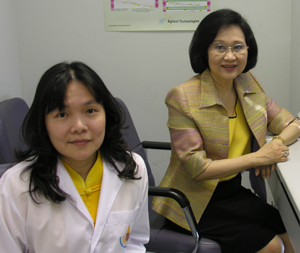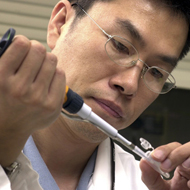
Environmental Factor, January 2008, National Institute of Environmental Health Sciences
Study Links Gene Expression Changes in Babies to Arsenic Exposure
By Eddy Ball
January 2008

In a study made possible by NIEHS extramural funding, a team of researchers from the Massachusetts Institute of Technology (MIT) and Thailand’s Chulabhorn Research Institute (CRI) have identified for the first time a highly predictive biomarker gene set for prenatal arsenic exposure. According to the authors, who published the study in the journal PLoS Genetics, the results of the study clearly demonstrated “that prenatal exposure in humans results in measurable phenotypic responses in the newborn.”
Results of earlier rodent studies, the authors note, suggest that “in utero arsenic exposure may result in epigenetic changes that persist through the life of the organism, ultimately impacting health status.” Duke University researcher Randy Jirtle, Ph.D., has compared the epigenome to computer software due to the similarities between how it influences gene expression within the genome and the way software controls the efficient operation of computer hardware.
Arsenic contamination is a health concern worldwide with millions exposed to levels that exceed the World Health Organization (WHO) safety standard of 10 parts per billion (ppb). The element was classified as a Group 1 carcinogen by the International Agency for Research on Cancer and has been implicated in such diseases as vascular disorders and diabetes.
The research was led by Mathuros Ruchirawat, Ph.D., director of the CRI Laboratory of Environmental Toxicology in Bangkok, working with Leona Samson, Ph.D., director of the MIT Center for Environmental Health Sciences and the American Cancer Society professor in the departments of Biological Engineering and Biology. Rebecca Fry, Ph.D., a research scientist at the MIT Environmental Health Sciences Center, was lead author of the study. (http://www.pubmedcentral.nih.gov/articlerender.fcgi?artid=2082467) ![]()


The investigators recruited 32 healthy, pregnant women between the ages of 20 and 40 for the study. Twenty three of the women lived in the Ron Pibul District of southern Thailand in villages that had been classified as high-level arsenic contaminated areas as a result of extensive tin mining from the 1960’s to 1980’s. Levels of arsenic in groundwater in the area are as much as 50 times the WHO standard. Women with toenail arsenic levels representing exposure below the WHO limit of 10ppb served as a control group.
During the subjects’ pregnancies, the Chulabhorn investigators collected toenail samples, which were analyzed for total arsenic concentrations that reflect past exposures. After delivery of the women’s children, a sample of newborn cord blood was collected for microarray analysis of gene expression. The researchers then performed data analysis to identify genes that showed modulated expression as a result of prenatal exposure and also to determine transcription factor binding sites and molecular interactions.
Microarray analysis identified approximately 450 genes that were differentially expressed between the two populations, 90 percent of them showing an increase in expression level. The MIT investigators were able to isolate three arsenic-associated gene expression signatures and found that even the smallest set, which included eleven genes, showed 83 percent accuracy in predicting prenatal arsenic exposure. The eleven genes fall into gene ontology categories related to cell growth and death, stress and immune response, and inflammation.
“We were looking to see whether we could have figured out [from gene expression screening] that these babies were exposed in utero,” Samson explained. “The answer was a resounding ‘yes.’”
The government is aware of the arsenic contamination and, according to Fry, has provided alternative water sources to the affected villages in the Ron Pibul District.
The research was supported by NIEHS Division of Extramural Research and Training grants funding the MIT Center for Environmental Health Sciences and the development of in vitro alternative toxicity and carcinogenicity testing employing microarray and bioinformatics analysis. The grants are administered by Program Administrator Les Reinlib, Ph.D., and Acting Deputy Director Bill Suk Ph.D., who is on detail from his position as director of the Superfund Basic Research Program. In his work as part of the NIEHS global environmental health effort, Suk has collaborated with the Chulabhorn Research Institute.
"Translesion DNA..." - previous story ![]()
![]() next story - "Superfund Looks..."
next story - "Superfund Looks..."
January 2008 Cover Page



